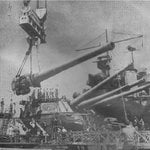The Royal Navy went, for several reasons, for 14 in guns for their King George V battle ships. What would be the benefits, apart from obvious (better range shell power, going with more or less modified existing guns)? What would be the drawbacks? How many bigger guns would be the ship of that size able to carry, without compromising the other important 'ingredients' (protection, speed etc) of the class?
MODERATORS: this is definitely a wrong subforum for this topic, please remove it to the ww2 one
MODERATORS: this is definitely a wrong subforum for this topic, please remove it to the ww2 one

